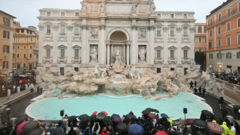The fountain, originally commissioned in 1730 by Pope Clement XII, remains a significant historical site located on the facade of the Poli Palace. It was designed by architect Nicola Salvi and completed in the 18th century. The fountain's structural integrity faced challenges as early as 2012, necessitating a multi-million euro renovation when parts of its ornate cornice began to crumble due to harsh winters.
Sunday's reopening attracted hundreds of tourists, many following tradition by tossing coins into the fountain, a practice that remarkably generates around €10,000 weekly for charity, supporting meals for those in need. The fountain symbolizes not only a key part of ancient Rome's aqueduct system, specifically the Acqua Vergine, which spans 20 km, but also offers a unique drinking tap for visitors.
Rooted in legend, the fountain's name derives from a tale of Roman soldiers led by a young virgin to discover the life-giving waters, forever cementing its place in both Roman culture and modern tourism. The re-opening of the Trevi Fountain marks a renewed commitment to both its historical significance and the experience of those who wish to explore its beauty.
Sunday's reopening attracted hundreds of tourists, many following tradition by tossing coins into the fountain, a practice that remarkably generates around €10,000 weekly for charity, supporting meals for those in need. The fountain symbolizes not only a key part of ancient Rome's aqueduct system, specifically the Acqua Vergine, which spans 20 km, but also offers a unique drinking tap for visitors.
Rooted in legend, the fountain's name derives from a tale of Roman soldiers led by a young virgin to discover the life-giving waters, forever cementing its place in both Roman culture and modern tourism. The re-opening of the Trevi Fountain marks a renewed commitment to both its historical significance and the experience of those who wish to explore its beauty.



















